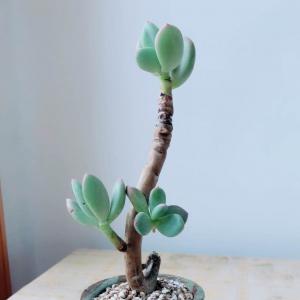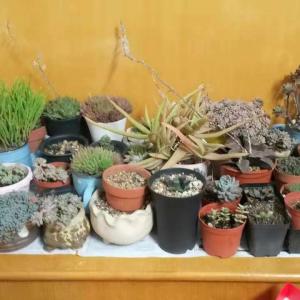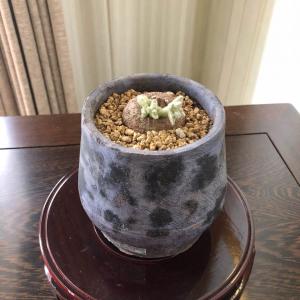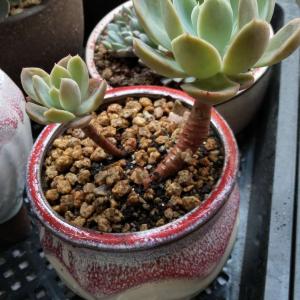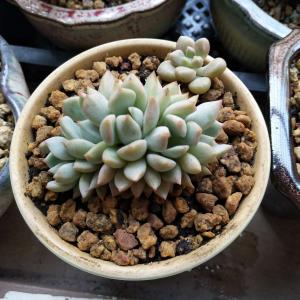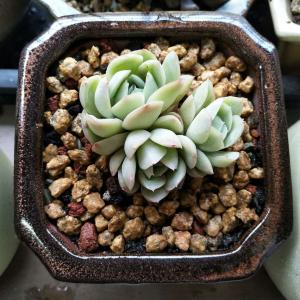成长记
🌱快乐🌸花儿🌿
2018年04月01日

桅子花叶子发黄的原因
1光照不当
a、光照过强,叶子朝阳部分出现黄斑,这时只需要将其移到阴处养护就可以恢复,新长出的叶子不会再有黄斑。
b、阳光不足,这时叶片会变黄甚至脱落,只要放到太阳底下进行补充阳光就可以了。
2水分不当
a、浇水过多,这种情况桅子花嫩叶暗黄且无光泽,但是老叶无明显变化,这时只要将花卉从盆里拿出置于通风阴凉处,等土干后再放回去。
b、缺水,叶梢或边缘发枯、发干,老叶自下而上枯黄脱落,但是这种情况新叶生长比较正常,此时应浇足、浇透水.
3施肥不当
a、施肥过多,主要表现在新叶顶尖出现褐色,叶面肥厚而无光泽,老叶片焦黄脱落。这时就要立即停止施肥,严重的还要对土壤进行冲洗,降低浓度。
b、肥料不 足,肥料不足也会引起植株发黄,比如缺铁,叶片呈淡黄色或白色,叶脉仍是绿色,这时要喷洒0.2%-0.5%的硫酸亚铁水进行防治;缺镁,先老叶发黄,接 着新叶发黄,叶脉仍呈绿色,这时可喷洒0.7%一0.8%硼镁肥防治.
4温度过低
温度过低也会引起叶片黄化,只要把它移进温度高处即可。
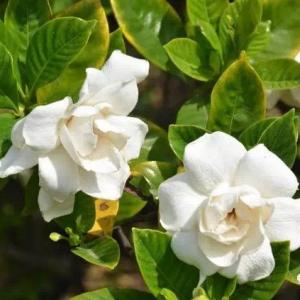
1光照不当
a、光照过强,叶子朝阳部分出现黄斑,这时只需要将其移到阴处养护就可以恢复,新长出的叶子不会再有黄斑。
b、阳光不足,这时叶片会变黄甚至脱落,只要放到太阳底下进行补充阳光就可以了。
2水分不当
a、浇水过多,这种情况桅子花嫩叶暗黄且无光泽,但是老叶无明显变化,这时只要将花卉从盆里拿出置于通风阴凉处,等土干后再放回去。
b、缺水,叶梢或边缘发枯、发干,老叶自下而上枯黄脱落,但是这种情况新叶生长比较正常,此时应浇足、浇透水.
3施肥不当
a、施肥过多,主要表现在新叶顶尖出现褐色,叶面肥厚而无光泽,老叶片焦黄脱落。这时就要立即停止施肥,严重的还要对土壤进行冲洗,降低浓度。
b、肥料不 足,肥料不足也会引起植株发黄,比如缺铁,叶片呈淡黄色或白色,叶脉仍是绿色,这时要喷洒0.2%-0.5%的硫酸亚铁水进行防治;缺镁,先老叶发黄,接 着新叶发黄,叶脉仍呈绿色,这时可喷洒0.7%一0.8%硼镁肥防治.
4温度过低
温度过低也会引起叶片黄化,只要把它移进温度高处即可。

0
0
成长记
🌱快乐🌸花儿🌿
2018年04月01日

栀子花的养殖方法
1环境因素
置于阴凉处,栀子花千万不能放在烈日下暴晒,否则会造成叶子枯黄,但也不是说要放在全阴处,因为它对光线有一定的需求,最好是能放在保持每日60%光照处,另外,进入四月份后,一个月要进行两次施肥。
2酸碱性
酸土培养,栀子花需要散射光,所以喜欢酸土,如果土壤呈碱性,就会使得栀子花无法很好的吸收铁元素,从而对叶绿素的形成有很大的影响,进一步造成花枝枯萎,甚至死亡;所以其土壤一定要使用疏松、肥沃的酸性土壤,也可将部分具有这样效果的物质加入其中。
3空气湿度
栀子花喜湿,因此空气的不能太干,据专家统计,如果空气湿度低于70%,就会影响花朵的正常开放, 但是如果过湿的话,又会引起根茎烂,叶发黄,所以除了正常浇水外,还要在附近经常喷洒清水,另外一个要非常注意的问题,水不能浇过多,不然也会影响生长, 那么栀子花该怎么浇水呢?
看到土干了的时候,用手敲花盆,如果有空空的声音,就需要浇水,花盆底部开始漏水就停止,浇的水最好是能加入一些鸡蛋、豆浆等,这样更利于生长。
4施肥要诀
栀子花喜肥,但是不能一次性加入过多的肥料,一定要薄肥多施,千万不能贪省事,不然会造成枝粗,大叶、浓绿,就失去了它本身的欣赏效果了。
5温度要求
栀子花的生长温度不能太低,因为它喜温,一般来说,生长期的温度在18至22度为佳,冬天5至10度,如果低于零下10度就会冻伤,这点北方要特别注意。
6适当修剪
栀子非常容易生长的枝繁叶茂,并造成密不透风且杂乱无章的感觉,这样会造成营养分散以及观赏性变 差,这样就需要给它修剪,修剪时最好选留3个主枝,并随时剪除根蘖萌出新枝,花谢后枝条要及时截短,这样的话,在剪口下会萌发新枝。当新枝长出三节后就要 进行摘心,以免盲目生长。
7防病
通常我们见到的栀子花的病有四种:
a、缺铁,这是最常见的一种,缺铁会造成叶绿素的形成,然后使得叶子失去绿色,这时候可以用硫酸亚铁水和低浓度黑矾水,每月三次。
b、缺镁,缺镁会导致栀子下部老叶叶脉发黄,这时就需要用低浓度的硫酸镁溶液喷施。
c、土质过湿或过干,这个可以参看第三点
d、太阳暴晒,这个可以参考第二点。
8繁殖方法
栀子一般有两种繁殖方法:扦插和压条
a、扦插,在梅雨季节用嫩枝15厘米长,插于苗床,10—12天生根
b、4月选取二年生枝条,长2O—25厘米,压埋在土中,保持湿润,约3O天生根,夏季与母株分离,翌春分栽。
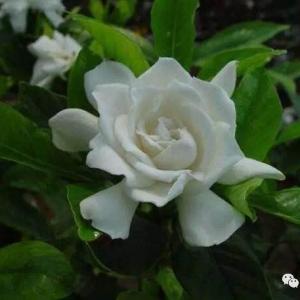
1环境因素
置于阴凉处,栀子花千万不能放在烈日下暴晒,否则会造成叶子枯黄,但也不是说要放在全阴处,因为它对光线有一定的需求,最好是能放在保持每日60%光照处,另外,进入四月份后,一个月要进行两次施肥。
2酸碱性
酸土培养,栀子花需要散射光,所以喜欢酸土,如果土壤呈碱性,就会使得栀子花无法很好的吸收铁元素,从而对叶绿素的形成有很大的影响,进一步造成花枝枯萎,甚至死亡;所以其土壤一定要使用疏松、肥沃的酸性土壤,也可将部分具有这样效果的物质加入其中。
3空气湿度
栀子花喜湿,因此空气的不能太干,据专家统计,如果空气湿度低于70%,就会影响花朵的正常开放, 但是如果过湿的话,又会引起根茎烂,叶发黄,所以除了正常浇水外,还要在附近经常喷洒清水,另外一个要非常注意的问题,水不能浇过多,不然也会影响生长, 那么栀子花该怎么浇水呢?
看到土干了的时候,用手敲花盆,如果有空空的声音,就需要浇水,花盆底部开始漏水就停止,浇的水最好是能加入一些鸡蛋、豆浆等,这样更利于生长。
4施肥要诀
栀子花喜肥,但是不能一次性加入过多的肥料,一定要薄肥多施,千万不能贪省事,不然会造成枝粗,大叶、浓绿,就失去了它本身的欣赏效果了。
5温度要求
栀子花的生长温度不能太低,因为它喜温,一般来说,生长期的温度在18至22度为佳,冬天5至10度,如果低于零下10度就会冻伤,这点北方要特别注意。
6适当修剪
栀子非常容易生长的枝繁叶茂,并造成密不透风且杂乱无章的感觉,这样会造成营养分散以及观赏性变 差,这样就需要给它修剪,修剪时最好选留3个主枝,并随时剪除根蘖萌出新枝,花谢后枝条要及时截短,这样的话,在剪口下会萌发新枝。当新枝长出三节后就要 进行摘心,以免盲目生长。
7防病
通常我们见到的栀子花的病有四种:
a、缺铁,这是最常见的一种,缺铁会造成叶绿素的形成,然后使得叶子失去绿色,这时候可以用硫酸亚铁水和低浓度黑矾水,每月三次。
b、缺镁,缺镁会导致栀子下部老叶叶脉发黄,这时就需要用低浓度的硫酸镁溶液喷施。
c、土质过湿或过干,这个可以参看第三点
d、太阳暴晒,这个可以参考第二点。
8繁殖方法
栀子一般有两种繁殖方法:扦插和压条
a、扦插,在梅雨季节用嫩枝15厘米长,插于苗床,10—12天生根
b、4月选取二年生枝条,长2O—25厘米,压埋在土中,保持湿润,约3O天生根,夏季与母株分离,翌春分栽。

0
0
文章
Miss Chen
2018年04月01日

Description: This perennial herbaceous plant is 1½–3¼' tall, branching occasionally to frequently. The stems are light green to brownish red, terete, and hairless to hairy. Sessile leaves alternate along the stems. The early leaves of this plant, after it emerges from the ground during the spring, are trifoliate-pinnatifid in structure. and their leaflets are sessile. The middle leaflet is cleft into 1-2 pairs of larger lateral lobes and a prominent terminal lobe; it also has smaller cleft lobes or coarse teeth along its margins. The lateral leaflets are more asymmetric in shape; the lateral leaflets typically are cleft into 1-2 larger outer lobes, 0-1 larger inner lobes, and there are several smaller lobes or coarse teeth along their margins. The lobes of these early leaves are oblong-lanceolate to linear-lanceolate in shape. Later leaves are trifoliate with simple leaflets; their sessile leaflets are 2–3½" long, narrowly lanceolate or elliptic in shape, and the margins of these leaflets are coarsely serrate or double-serrate (or rarely shallowly cleft). The upper leaf surface is yellowish green to medium green and sparsely short-pubescent to hairless, while the lower leaf surface is more pale and sparsely to abundantly glandular short-pubescent. Young leaves are more yellowish and hairy than mature leaves. At the leaf bases, there are pairs of persistent leafy stipules about ½–1" long; they are sessile. Individual stipules are ovate to reniform-orbicular in shape; they are shallowly cleft or coarsely serrated along their margins. The upper and lower surfaces of the stipules are similar to those of the leaves.
Upper stems terminate in either individual flowers or small cymes of 2-5 flowers. The branches of the cymes and pedicels of the flowers are slender and hairless to sparsely short-pubescent; the pedicels are ½–2" long. Individual flowers are ¾–1¼" across when they are fully open. Each flower consists of a short-cylindrical calyx with 5 upright teeth, 5 spreading white petals, 10-20 stamens, and 5 clustered pistils. The calyx is about ¼" long, light green to red, and hairless to sparsely short-pubescent; its small teeth are triangular in shape. The petals are narrowly elliptic or narrowly oblanceolate-elliptic in shape. The stamens have short filaments and light brown to dark brown anthers. The blooming period occurs from early to mid-summer, lasting about 2-3 weeks. Afterwards, individual flowers are replaced by 5 clustered follicles that are partially exserted from the persistent calyx. Individual follicles are about ½" long, 3-angled-ovoid in shape with slender beaks, and few-seeded; they eventually split open to release their seeds. Mature individual seeds are about 2.5 mm. long, reddish brown, broadly oblongoid-ellipsoid in shape, flattened along one side, and minutely pitted. The root system is fibrous and rhizomatous. During the autumn, the foliage of this plant becomes pinkish yellow or red.

Cultivation: The preference is mesic to dry-mesic conditions, partial sun, and clay-loam, loam, or rocky ground. This wildflower should be cultivated more often.
Range & Habitat: The native American Ipecac (Porteranthus stipulatus) occurs occasionally in the southern half of Illinois, while in the rest of the state it is absent or rare (see Distribution Map). Illinois lies along the northern range-limit of this species. Habitats include upland woodlands, rocky wooded slopes, upland savannas, and limestone glades. Oak trees (Quercus spp.) are usually the dominant canopy trees in these habitats. Occasional wildfires are probably beneficial in maintaining populations of this species. It usually occurs in higher quality natural areas.

Faunal Associations: The nectar and pollen of the flowers attract primarily bees, including Anthophorine bees (Anthophora spp.), little carpenter bees (Ceratina spp.), resin bees (Heriades spp.), mason bees (Hoplitis spp., Osmia spp.), leaf-cutter bees (Megachile spp.), Halictid bees (Lasioglossum spp.), and dagger bees (Calliopsis spp.). Other insect pollinators include nectar-seeking butterflies, skippers, bee flies (Bombyliidae), and thick-headed flies (Conopidae); see Robertson (1929) and Rudolph et al. (2006). The foliage is toxic to mammalian herbivores.
Photographic Location: An upland woodland along Lake Charleston in Coles County, Illinois, and the wildflower garden of the webmaster in Urbana, Illinois.

Comments: American Ipecac (Porteranthus stipulatus) has a distinctive appearance, particularly during the relatively short period when it is in bloom. The stipules of this plant are unusually large in size and persistent. Another similar species, Bowman's Root (Porteranthus trifoliatus), occurs further to the east in the Appalachian Mountains, but it has not been found in Illinois as a native or naturalized wildflower. Compared to American Ipecac, this latter species has much smaller stipules along its stems and they are early-deciduous, rather than persistent. Bowman's Root has flowers with slightly longer petals and a longer cylindrical calyx; the leaflets of this plant are also wider than those of American Ipecac. Both of these plants have been referred to as Indian Physic, and some authorities assign them to the Gillenia genus. Thus, a scientific synonym of American Ipecac is Gillenia stipulata.
Upper stems terminate in either individual flowers or small cymes of 2-5 flowers. The branches of the cymes and pedicels of the flowers are slender and hairless to sparsely short-pubescent; the pedicels are ½–2" long. Individual flowers are ¾–1¼" across when they are fully open. Each flower consists of a short-cylindrical calyx with 5 upright teeth, 5 spreading white petals, 10-20 stamens, and 5 clustered pistils. The calyx is about ¼" long, light green to red, and hairless to sparsely short-pubescent; its small teeth are triangular in shape. The petals are narrowly elliptic or narrowly oblanceolate-elliptic in shape. The stamens have short filaments and light brown to dark brown anthers. The blooming period occurs from early to mid-summer, lasting about 2-3 weeks. Afterwards, individual flowers are replaced by 5 clustered follicles that are partially exserted from the persistent calyx. Individual follicles are about ½" long, 3-angled-ovoid in shape with slender beaks, and few-seeded; they eventually split open to release their seeds. Mature individual seeds are about 2.5 mm. long, reddish brown, broadly oblongoid-ellipsoid in shape, flattened along one side, and minutely pitted. The root system is fibrous and rhizomatous. During the autumn, the foliage of this plant becomes pinkish yellow or red.

Cultivation: The preference is mesic to dry-mesic conditions, partial sun, and clay-loam, loam, or rocky ground. This wildflower should be cultivated more often.
Range & Habitat: The native American Ipecac (Porteranthus stipulatus) occurs occasionally in the southern half of Illinois, while in the rest of the state it is absent or rare (see Distribution Map). Illinois lies along the northern range-limit of this species. Habitats include upland woodlands, rocky wooded slopes, upland savannas, and limestone glades. Oak trees (Quercus spp.) are usually the dominant canopy trees in these habitats. Occasional wildfires are probably beneficial in maintaining populations of this species. It usually occurs in higher quality natural areas.

Faunal Associations: The nectar and pollen of the flowers attract primarily bees, including Anthophorine bees (Anthophora spp.), little carpenter bees (Ceratina spp.), resin bees (Heriades spp.), mason bees (Hoplitis spp., Osmia spp.), leaf-cutter bees (Megachile spp.), Halictid bees (Lasioglossum spp.), and dagger bees (Calliopsis spp.). Other insect pollinators include nectar-seeking butterflies, skippers, bee flies (Bombyliidae), and thick-headed flies (Conopidae); see Robertson (1929) and Rudolph et al. (2006). The foliage is toxic to mammalian herbivores.
Photographic Location: An upland woodland along Lake Charleston in Coles County, Illinois, and the wildflower garden of the webmaster in Urbana, Illinois.

Comments: American Ipecac (Porteranthus stipulatus) has a distinctive appearance, particularly during the relatively short period when it is in bloom. The stipules of this plant are unusually large in size and persistent. Another similar species, Bowman's Root (Porteranthus trifoliatus), occurs further to the east in the Appalachian Mountains, but it has not been found in Illinois as a native or naturalized wildflower. Compared to American Ipecac, this latter species has much smaller stipules along its stems and they are early-deciduous, rather than persistent. Bowman's Root has flowers with slightly longer petals and a longer cylindrical calyx; the leaflets of this plant are also wider than those of American Ipecac. Both of these plants have been referred to as Indian Physic, and some authorities assign them to the Gillenia genus. Thus, a scientific synonym of American Ipecac is Gillenia stipulata.
0
0
文章
Miss Chen
2018年04月01日

Description: This perennial wildflower is 1-1¾' tall, producing one or more leafy stems from the root system that are erect to ascending. These stems are light green to reddish purple, terete, and usually unbranched; they are rough-canescent above and mostly glabrous below. Alternate leaves occur along these stems that are variable in size: toward the bottom of each central stem, the leaf blades are small and scale-like, while along the middle to upper parts of the stem they are 1-2½" long and ¼-¾" across. The middle to upper leaf blades are narrowly lanceolate to ovate and smooth to finely serrated along their margins; the margins are often slightly ciliate. The typical variety of Seneca Snakeroot has narrow leaf blades less than ½" across, while var. latifolia has wider leaf blades that sometimes exceed ½" across. The upper blade surface is yellowish to medium green and glabrous to sparsely canescent, while the lower blade surface is pale green and sparsely canescent. The petioles of the leaves are 1/8" (3 mm.) long or less.

The central stem (and any lateral stems) terminates in a spike-like raceme of flowers about 1½-3" long; the small flowers are arranged densely along the central stalk of the raceme, blooming from the bottom to the top. The central stalk of the raceme is light green and canescent. Individual flowers are about 1/8" (3 mm.) across, consisting of 3 white petals, 2 white petaloid sepals, 3 light green to purple non-petaloid sepals, 8 stamens that are arranged in 2 rows, and a pistil with a single style. The petals form a tubular corolla around the reproductive organs of the flower, while the petaloid sepals form lateral wings. One of the petals is usually fringed. The inconspicuous pedicels of the flowers are less than 1/8" (3 mm.) in length. The blooming period occurs from late spring to early summer and lasts about 3-4 weeks. The flowers are replaced by 2-celled seed capsules that 2-4 mm. long, 3-4 mm. across, and somewhat flattened. Each cell of the capsule contains a single lanceoloid seed about 1/8" long that is slightly hairy toward the bottom. The root system consists of a slightly woody crown or taproot with secondary fibrous roots.
Cultivation: The preference is full or partial sun, dry-mesic conditions, and soil containing loam, clay-loam, or rocky material.
Range & Habitat: Seneca Snakeroot is occasional in northern and central Illinois, while in the southern part of the state it is largely absent (see Distribution Map). Habitats include upland gravel prairies, hill prairies, savannas, wooded slopes along rivers or lakes, and abandoned fields. Occasional wildfires and other kinds of disturbance are beneficial if they reduce competition from woody vegetation.

Faunal Associations: Various small to medium-sized bees visit the flowers for nectar or pollen. Caterpillars of the moth, Phytometra rhodarialis (Pink-Border Yellow), feed on Polygala spp. (Milkworts). Mammalian herbivores probably feed on the foliage only to a limited extent, if at all, because of its bitterness.
Photographic Location: The Coneflower Hill Prairie near Lake Shelbyville in Moultrie County, Illinois. The photographed plant is the wide-leaved variety of Seneca Snakeroot, Polygala senega latifolia.
Comments: The flowers of Seneca Snakeroot have a bud-like appearance even when they are open. For this species, there is some significant variability in the width of the leaves and the size of the seed capsules and their seeds. In Illinois, other Polygala spp. (Milkworts) have non-white flowers or their leaves are whorled, rather than alternate. They also tend to be smaller in size overall than Seneca Snakeroot. Therefore, it is fairly easy to distinguish Seneca Snakeroot from these other species. This species also superficially resembles some Persicaria spp. (Smartweeds) with white flowers, however the latter have conspicuous ochreae (sheaths) that wrap around their stems and they prefer wetter habitats. Seneca Snakeroot also has floral racemes that superficially resemble those of Orbexilum pedunculatum (Sampson's Snakeroot), but the latter species can be easily distinguished by its trifoliate leaves.

The central stem (and any lateral stems) terminates in a spike-like raceme of flowers about 1½-3" long; the small flowers are arranged densely along the central stalk of the raceme, blooming from the bottom to the top. The central stalk of the raceme is light green and canescent. Individual flowers are about 1/8" (3 mm.) across, consisting of 3 white petals, 2 white petaloid sepals, 3 light green to purple non-petaloid sepals, 8 stamens that are arranged in 2 rows, and a pistil with a single style. The petals form a tubular corolla around the reproductive organs of the flower, while the petaloid sepals form lateral wings. One of the petals is usually fringed. The inconspicuous pedicels of the flowers are less than 1/8" (3 mm.) in length. The blooming period occurs from late spring to early summer and lasts about 3-4 weeks. The flowers are replaced by 2-celled seed capsules that 2-4 mm. long, 3-4 mm. across, and somewhat flattened. Each cell of the capsule contains a single lanceoloid seed about 1/8" long that is slightly hairy toward the bottom. The root system consists of a slightly woody crown or taproot with secondary fibrous roots.
Cultivation: The preference is full or partial sun, dry-mesic conditions, and soil containing loam, clay-loam, or rocky material.
Range & Habitat: Seneca Snakeroot is occasional in northern and central Illinois, while in the southern part of the state it is largely absent (see Distribution Map). Habitats include upland gravel prairies, hill prairies, savannas, wooded slopes along rivers or lakes, and abandoned fields. Occasional wildfires and other kinds of disturbance are beneficial if they reduce competition from woody vegetation.

Faunal Associations: Various small to medium-sized bees visit the flowers for nectar or pollen. Caterpillars of the moth, Phytometra rhodarialis (Pink-Border Yellow), feed on Polygala spp. (Milkworts). Mammalian herbivores probably feed on the foliage only to a limited extent, if at all, because of its bitterness.
Photographic Location: The Coneflower Hill Prairie near Lake Shelbyville in Moultrie County, Illinois. The photographed plant is the wide-leaved variety of Seneca Snakeroot, Polygala senega latifolia.
Comments: The flowers of Seneca Snakeroot have a bud-like appearance even when they are open. For this species, there is some significant variability in the width of the leaves and the size of the seed capsules and their seeds. In Illinois, other Polygala spp. (Milkworts) have non-white flowers or their leaves are whorled, rather than alternate. They also tend to be smaller in size overall than Seneca Snakeroot. Therefore, it is fairly easy to distinguish Seneca Snakeroot from these other species. This species also superficially resembles some Persicaria spp. (Smartweeds) with white flowers, however the latter have conspicuous ochreae (sheaths) that wrap around their stems and they prefer wetter habitats. Seneca Snakeroot also has floral racemes that superficially resemble those of Orbexilum pedunculatum (Sampson's Snakeroot), but the latter species can be easily distinguished by its trifoliate leaves.
0
0





